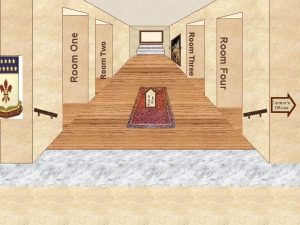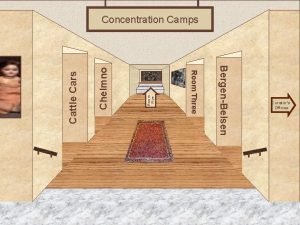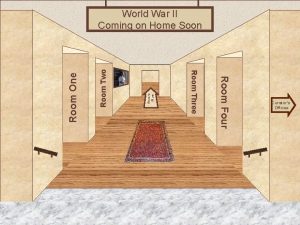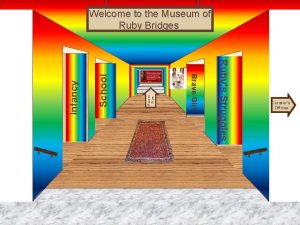Room Two Museum Entrance Room Five Room One




![[Room 3] Room 3 Return to Entry [Room 3] Room 3 Return to Entry](https://slidetodoc.com/presentation_image_h/903fc2d8146d44a63b0115a653a7511d/image-5.jpg)
![[Room 4] Room 4 Artifact 16 Return to Entry [Room 4] Room 4 Artifact 16 Return to Entry](https://slidetodoc.com/presentation_image_h/903fc2d8146d44a63b0115a653a7511d/image-6.jpg)
![[Room 5] Room 5 Artifact 18 Artifact 17 Artifact 19 Artifact 21 Return to [Room 5] Room 5 Artifact 18 Artifact 17 Artifact 19 Artifact 21 Return to](https://slidetodoc.com/presentation_image_h/903fc2d8146d44a63b0115a653a7511d/image-7.jpg)
























- Slides: 31

Room Two Museum Entrance Room Five Room One Artifact 23 Room Four Back Wall Artifact Room Three rtifact 22 Welcome to the Museum of [Name of Museum] Curator’s Offices

Derrick Knoblock Curator’s Office Describe yourself here. Place your picture here. Contact me at [Your linked email address] Return to Entry Note: Virtual museums were first introduced by educators at Keith Valley Middle School in Horsham, Pennsylvania. This template was designed by Dr. Christy Keeler. View the Educational Virtual Museums website for more information on this instructional technique.

WW 2 Battles Room 1 Return to Entry

WW 2 Battles Room 2 Return to Entry
![Room 3 Room 3 Return to Entry [Room 3] Room 3 Return to Entry](https://slidetodoc.com/presentation_image_h/903fc2d8146d44a63b0115a653a7511d/image-5.jpg)
[Room 3] Room 3 Return to Entry
![Room 4 Room 4 Artifact 16 Return to Entry [Room 4] Room 4 Artifact 16 Return to Entry](https://slidetodoc.com/presentation_image_h/903fc2d8146d44a63b0115a653a7511d/image-6.jpg)
[Room 4] Room 4 Artifact 16 Return to Entry
![Room 5 Room 5 Artifact 18 Artifact 17 Artifact 19 Artifact 21 Return to [Room 5] Room 5 Artifact 18 Artifact 17 Artifact 19 Artifact 21 Return to](https://slidetodoc.com/presentation_image_h/903fc2d8146d44a63b0115a653a7511d/image-7.jpg)
[Room 5] Room 5 Artifact 18 Artifact 17 Artifact 19 Artifact 21 Return to Entry Artifact 20

Operation Mincemeat was a successful British disinformation plan during the Second World War. As part of Operation Barclay, the widespread deception intended to cover the invasion of Italy from North Africa, Mincemeat helped to convince the German high command that the Allies planned to invade Greece and Sardinia in 1943 instead of Sicily, the actual objective. This was accomplished by persuading the Germans that they had, by accident, intercepted "top secret" documents giving details of Allied war plans. The documents were attached to a corpse deliberately left to wash up on a beach in Punta Umbría in Spain. The success of the planting of false documents was confirmed through Ultra decrypts of German messages. http: //www. bing. com/images/search? q=battle+of+atlantic&view=detail v 2&&&id=D 0336 BA 1 BA 5 FB 1040883 A 9 EE 1 C 740 B 68 F 654 A 7 AC&sele cted. Index=1&ccid=j. TWx. BZOD&simid=608010560443844973&thid=J N. LWYhf. Lk 4 jd. V 9 xo 2 REAGYd. A&ajaxhist=0 Return to Exhibit

Battle of the Atlantic The Battle of the Atlantic was the longest continuous military campaign in World War II, running from 1939 to the defeat of Germany in 1945. At its core was the Allied naval blockade of Germany, announced the day after the declaration of war, and Germany's subsequent counter-blockade. It was at its height from mid-1940 through to the end of 1943. The Battle of the Atlantic pitted U-boats and other warships of the Kriegsmarine and aircraft of the Luftwaffe against the Royal Canadian Navy, Royal Navy, and Allied merchant shipping. The convoys, coming mainly from North America http: //www. pacificwar. org. au/webgraphi cs/Atlantic/800 px. Atlantic_Merchant_Casualty. JPEG Return to Exhibit

Battle of Dieppe The Dieppe Raid, also known as the Battle of Dieppe, Operation Rutter and, later, Operation Jubilee, was an Allied attack on the German-occupied port of Dieppe during the Second World War. The raid took place on the northern coast of France on 19 August 1942. the Allied commanders were forced to call a retreat. Over 6, 000 infantrymen, predominantly Canadian, were supported by The Calgary Regiment of the 1 st Canadian Tank Brigade and a strong force of Royal Navy and smaller Royal Air Force landing contingents. It involved 5, 000 Canadians, 1, 000 British troops, and 50 United States http: //0. tqn. com/d/canadaonline/1/ S/K/A/dieppebodies. jpg Return to Exhibit

Battle of Bloody Gulch The Battle of Bloody Gulch took place near Hill 69 approximately 1 mile southwest of Carentan in Normandy, France on June 13, 1944, between elements of the German 17 th SS Panzergrenadier Division and 6 th Fallschirmjäger Regiment, and the American 501 st, 502 nd and 506 th, Parachute Infantry Regiments of the U. S. 101 st Airborne Division, reinforced by elements of the U. S. 2 nd http: //4. bp. blogspot. com/D 36 r. QY_d. Rp. E/UFf. CCgbom. CI/AAAADKI/k. L 5_Uk CQlo. A/s 1600/Antietam+Bloody+Lane. jpg Return to Exhibit

Pearl Harbor was a surprise military strike conducted by the Imperial Japanese Navy against the United States naval base at Pearl Harbor, in the United States Territory of Hawaii, on the morning of December 7, 1941. http: //3. bp. blogspot. com/_77 ITy. OSp. Xs 8/TPg 7 mj. P 2 7_I/AAAABA/Fy. Gqme. GILp. M/s 1600/burning. Docks. Pearl. Harbor-attack. jpg Return to Exhibit

Battle of the Coral Sea The Battle of the Coral Sea, fought during 4– 8 May 1942, was a major naval battle in the Pacific Theater of World War II between the Imperial Japanese Navy and naval and air forces from the United States and Australia. The battle was the first action in which aircraft carriers engaged each other, as well as the first in which neither side's ships sighted or fired directly upon the other. http: //historywarsweapons. com/wpcontent/uploads/image/Battle. Of. Cor al. Sea 2. JPG Return to Exhibit

Battle of Dresden The Battle of Dresden was fought on 26– 27 August 1813 around Dresden, Germany, resulting in a French victory under Napoleon against forces of the Sixth Coalition of Austrians, Russians and Prussians under Field Marshal Schwartzenberg. However, Napoleon's victory was not as complete as it could have been. Substantial pursuit was not undertaken after the battle, and the flanking corps was surrounded and forced to surrender a few days later at the Battle of Kulm. http: //napoleonicwars. web. fc 2. com/ painting/war/Leipzig. jpg Return to Exhibit

Battle of Iwo Jima The Battle of Iwo Jima was a major battle in which the United States Armed Forces landed and eventually captured the island of Iwo Jima from the Japanese Imperial Army during World War II. The American invasion, designated Operation Detachment, had the goal of capturing the entire island, including the three Japanesecontrolled airfields, to provide a staging area for attacks on the Japanese main islands. This five-week battle comprised some of the fiercest and bloodiest fighting of the War in the Pacific of World War II. http: //www. history. com/s 3 static/video-thumbnails/AETNHistory_VMS/21/152/History_Report_Battle_of_Iwo_Jim a_Speech_SF_still_624 x 352. jpg Return to Exhibit

Battle of Moscow The Battle of Moscow is the name given by Soviet historians to two periods of strategically significant fighting on a 600 km sector of the Eastern Front during World War II. It took place between October 1941 and January 1942. The Soviet defensive effort frustrated Hitler's attack on Moscow, capital of the Union of Soviet Socialist Republics and the largest Soviet city. Moscow was one of the primary military and political objectives for Axis forces in their invasion of the Soviet Union. http: //3. bp. blogspot. com/Q 0 AS 6 j. MYL 5 w/T 0 c 5 E 7 q. Fs. OI/AAAAIXo/ZZv YKVh. Yug. A/s 1600/battle-of-moscow-ww 2 -194111 th-armored-division-kaluga. jpg Return to Exhibit

Battle of Midway The Battle of Midway was a crucial and decisive naval battle in the Pacific Theatre of World War II. Between 3 and 6 June 1942, only six months after Japan's attack on Pearl Harbor and one month after the Battle of the Coral Sea, the United States Navy under Admirals Chester Nimitz, Frank Jack Fletcher, and Raymond A. Spruance decisively defeated an attacking fleet of the Imperial Japanese Navy under Admirals Isoroku Yamamoto, Chuichi Nagumo, and Nobutake Kondo near Midway Atoll, inflicting devastating damage on the Japanese fleet that proved irreparable http: //blog. nsavides. com/wpcontent/uploads/2012/03/battle-ofmidway. jpg Return to Exhibit

Battle of Sicliy The Allied invasion of Sicily, codenamed Operation Husky, was a major World War II campaign, in which the Allies took Sicily from the Axis Powers. It was a large scale amphibious and airborne operation, followed by six weeks of land combat. It launched the Italian Campaign. http: //www. inilossum. com/2 gue_image/ 2 guerr 3218. gif Return to Exhibit

D-day D-Day is the day on which a combat attack or operation is to be initiated. The best known DDay is June 6, 1944—the day of the Normandy landings— initiating the Western Allied effort to liberate mainland Europe from Nazi occupation during World War II. However, many other invasions and operations had a designated DDay, both before and after that operation. http: //www. historybyzim. com/wpcontent/uploads/2012/06/D-Day-Getting -off-the-Ships. jpg Return to Exhibit

Fall of Poland The Invasion of Poland, also known as the September Campaign, or the 1939 Defensive War in Poland, and alternatively the Poland Campaign or Fall Weiß in Germany, was a joint invasion of Poland by Germany, the Soviet Union, and a small Slovak contingent, that marked the beginning of World War II in Europe. The German invasion began on 1 September 1939, one week after the signing of the Molotov–Ribbentrop Pact, while the Soviet invasion commenced on 17 September following the Molotov-Tōgō agreement that terminated http: //www. ushmm. org/lcmedia/photo/lc/ image/80/80487. jpg Return to Exhibit

Battle of Wake Island The Battle of Wake Island began simultaneously with the attack on Pearl Harbor and against those of the U. S. , with Marines playing a prominent role on both sides. ended on 23 December 1941, with the surrender of the American forces to the Empire of Japan. It was fought on and around the atoll formed by Wake Island its islets of Peale and Wilkes Islands by the air, land, and naval forces of the Empire of Japan http: //blog. bearstrong. net/max 256/uploa ded_images/Wake-Island-(1942)- 765560. jpg Return to Exhibit

Battle of Leyte Gulf The Battle of Leyte Gulf, formerly known as the Second Battle of the Philippine Sea, is generally considered to be the largest naval battle of World War II and, by some criteria, possibly the largest naval battle in history alongside the Battle of Red Cliffs in 208 CE and the Battle of Salamis in 480 BCE. http: //battleofleytegulf 1944. weebly. com/ uploads/1/8/1/3/18135949/3993186_ori g. jpg Return to Exhibit

Battle of Crete The Battle of Crete was fought during World War II on the Greek island of Crete. It began on the morning of 20 May 1941, when Nazi Germany launched an airborne invasion of Crete under the code name Unternehmen Merkur. Greek and Allied forces, along with Cretan civilians, defended the island. After one day of fighting, the Germans had suffered very heavy casualties and the Allied troops were confident that they would defeat invasion. The next day, through miscommunication and the failure of Allied commanders to grip the situation, Maleme airfield in western Crete fell to the Germans, enabling them to fly in reinforcements and overwhelm the defenders. The battle lasted about 10 days. http: //www. greek-islands. us/creteinformation/battle-of-crete. jpg Return to Exhibit

Battle of Corregidor The Battle of Corregidor was the culmination of the Japanese campaign for the conquest of the Commonwealth of the Philippines during World War II. The fall of Bataan on April 9, 1942 ended all organized opposition by the U. S. Army Forces Far East to the invading Japanese forces on Luzon in the northern Philippines. The island bastion of Corregidor, with its network of tunnels and formidable array of defensive armament, along with the fortifications across the entrance to Manila Bay, was the remaining obstacle to the 14 th Japanese Imperial Army of Lieutenant General Masaharu Homma. The Japanese had to take Corregidor http: //cf 067 b. medialib. glogster. com/media/0 f/0 f 6456 e 8 e 3 e 10 d 86 c 558 f 8 aa 09 e 6581 de 3 ebf 4 f 75 b 8 ae 77008292990 6327 eb 67/battle-of-corregidor-jpg. jpg Return to Exhibit

Battle of Bastogne The Siege of Bastogne was an engagement in December 1944 between American and German forces at the Belgian town of Bastogne, as part of the larger Battle of the Bulge. The goal of the German offensive was the harbour at Antwerp. In order to reach it before the Allies could regroup and bring their superior air power to bear, German mechanized forces had to seize the roadways through eastern Belgium. Because all seven main roads in the Ardennes mountain range converged on the small town of Bastogne, control of its crossroads was vital to the German attack. The siege lasted from December 20– 27, after which the besieged American forces were relieved by elements of General George Patton's Third Army http: //www. frumforum. com/wpcontent/uploads/2009/12/Bastogne. jpg Return to Exhibit

Battle of Dunkirk The Battle of Dunkirk was an important battle that took place in Dunkirk, France, during the Second World War between the Allies and Germany. As part of the Battle of France on the Western Front, the Battle of Dunkirk was the defence and evacuation of British and allied forces in Europe from 26 May– 4 June 1940. http: //3. bp. blogspot. com/w. DV 0 c. Xb 8 JKY/TX 7 o 85 dbm. FI/AAAAAOw/Vv 2 Zm_8 fr 2 w/s 1600/dunkirk 2. jpg Return to Exhibit

Battle of Stalingard The Battle of Stalingrad was a major battle of World War II in which Nazi Germany and its allies fought the Soviet Union for control of the city of Stalingrad in Southern Russia, on the eastern boundary of Europe. http: //www. cpcml. ca/images 2010/1942 Battleof. Stalingrad. Snipers-01. jpg Return to Exhibit

Battle of North Africa During the Second World War, the North African Campaign took place in North Africa from 10 June 1940 to 13 May 1943. It included campaigns fought in the Libyan and Egyptian deserts and in Morocco and Algeria and Tunisia. http: //www. paradata. org. uk/files/imagec ache/medium/files/pictures/na 176. jpg Return to Exhibit

Battle of Manila Navy The Battle of Manila Bay took place on 1 May 1898, during the Spanish–American War. The American Asiatic Squadron under Commodore George Dewey engaged and destroyed the Spanish Pacific Squadron under Admiral Patricio Montojo. The battle took place in Manila Bay in the Philippines, and was the first major engagement of the Spanish–American War. The battle was one of the most decisive naval battles in history and marked the end of the Spanish colonial period in Philippine history. http: //upload. wikimedia. org/wikipedia/commons /0/0 c/Manila. Bay. Battle. jpg Return to Entrance

Battle of Kursk The Battle of Kursk was a World War II engagement between German and Soviet forces on the Eastern Front near Kursk in the Soviet Union during July and August 1943. The German offensive was codenamed Operation Citadel and led to one of the largest armoured clashes in history, the Battle of Prokhorovka. The German offensive was countered by two Soviet counter-offensives, Operation Polkovodets Rumyantsev and Operation Kutuzov. For the Germans, the battle represented the final strategic offensive they were able to mount in the east. For the Soviets, the victory gave the Red Army the strategic initiative for the rest of the war. http: //10 awesome. com/wpcontent/uploads/2011/06/1. kursk_148. jp g Return to Entrance

Hiroshima and Nagasaki Bombing In August 1945, during the final stage of the Second World War, the United States dropped atomic bombs on the Japanese cities of Hiroshima and Nagasaki. The two bombings, which killed at least 129, 000 people, remain the only use of nuclear weapons for warfare in history https: //al 13 lea. files. wordpress. com/2008 /05/hiroshima-nagasaki-1. jpg Return to Exhibit
 Willow cabin speech
Willow cabin speech Ba-room ba-room ba-room baripity
Ba-room ba-room ba-room baripity One two three four five six seven eight nine ten
One two three four five six seven eight nine ten One two three four five six seven
One two three four five six seven Zero one two three
Zero one two three What is 0·125zero point one two five as a fraction?
What is 0·125zero point one two five as a fraction? One two three four five six
One two three four five six What is 0·125zero point one two five as a fraction?
What is 0·125zero point one two five as a fraction? Nine two one
Nine two one Three no four
Three no four One two three four five six numbers
One two three four five six numbers There is one art museum on the island of watsonia
There is one art museum on the island of watsonia One god one empire one religion
One god one empire one religion One one one little puppy run
One one one little puppy run One king one law one faith
One king one law one faith One god one empire one emperor
One god one empire one emperor One ford plan
One ford plan See one do one teach one
See one do one teach one See one, do one, teach one
See one, do one, teach one See one do one teach one
See one do one teach one One vision one identity one community
One vision one identity one community One vision one identity one community
One vision one identity one community Two mothers one on one
Two mothers one on one The sounding cataract haunted me
The sounding cataract haunted me Five of five
Five of five Five elements and five senses
Five elements and five senses Macbeth act five scene five
Macbeth act five scene five Module 5 topic 1 intersections
Module 5 topic 1 intersections Entrance hidden by bricks and rubble
Entrance hidden by bricks and rubble Loading bench radiology
Loading bench radiology Emphasis là loại hoạt cảnh gì
Emphasis là loại hoạt cảnh gì What are the three parts of an expressway entrance
What are the three parts of an expressway entrance























































